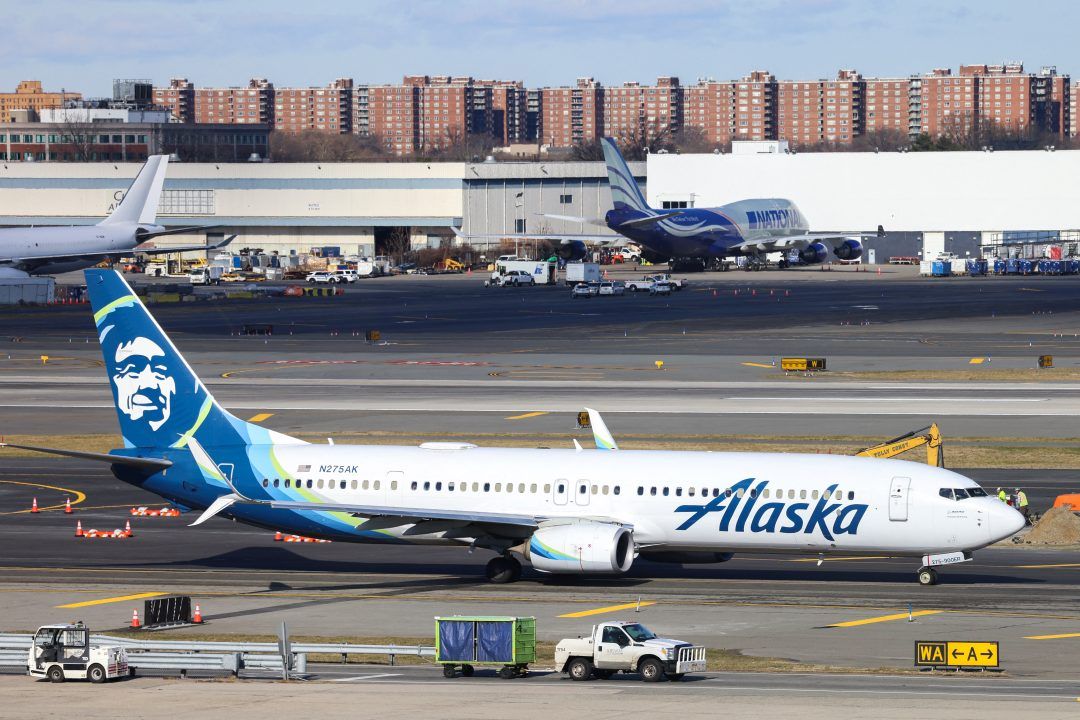
©(Photo by Charly TRIBALLEAU / AFP)
Both United and Alaska Airlines disclosed that they found loose hardware on certain Boeing 737 MAX 9 aircraft during initial inspections on Monday, following a significant mid-flight incident last week.
United and Alaska Airlines both reported on Monday that loose hardware had been discovered on some of their Boeing 737 MAX 9 planes during preliminary inspections after a dramatic mid-flight incident last week.
The disclosures come as US federal transportation inspectors probe what caused a so-called door plug component to blow out last Friday on an Alaska Airlines passenger plane, forcing it to make an emergency landing.
United said on Monday it had "found instances that appear to relate to installation issues in the door plug—for example, bolts that needed additional tightening."
Hours later, Alaska Airlines said its staff had found that "loose hardware was visible on some aircraft."
Boeing shares tumbled on Monday as investors began to assess the financial implications of the incident, while US aviation authorities provided airlines with protocols to check planes with similar configurations to the 737 MAX 9 aircraft involved in Friday's incident.
National Transportation Safety Board (NTSB) inspectors said late Monday that they did not find bolts for the component that came off on Friday's Alaska Airlines flight, but hadn't determined whether they existed or had flown off with the panel.
Hundreds of flights have been canceled due to the grounding of a fraction of the MAX fleet.
Aviation analysts said the issue appeared to be a quality control defect rather than a design issue, akin to the problem with a flawed flight handling system involved in two fatal MAX crashes in 2018 and 2019.
But Boeing has struggled with supply chain and quality control problems since the MAX returned to service, limiting its output and hitting its bottom line.
In December, Boeing urged airlines to undertake additional inspections to check for loose hardware on plane rudder control systems after an international operator discovered a bolt with a missing nut while performing routine maintenance.
The US airline said it has canceled 200 MAX 9 flights since the incident and expects "significant cancelations" on Tuesday.
On Monday, the Federal Aviation Administration (FAA) announced that it approved a roadmap for airlines to complete inspections that include both left and right door plugs, components and fasteners.
Alaska Airlines said it was still awaiting "final documentation" from Boeing and the FAA before beginning the formal inspection process.
AeroMexico, which has suspended 19 planes, said it is in the "final phase" of inspections, adding, "We expect all MAX-9s in our fleet to return to operation in the upcoming days."
Khalil Wakim, with AFP
United and Alaska Airlines both reported on Monday that loose hardware had been discovered on some of their Boeing 737 MAX 9 planes during preliminary inspections after a dramatic mid-flight incident last week.
The disclosures come as US federal transportation inspectors probe what caused a so-called door plug component to blow out last Friday on an Alaska Airlines passenger plane, forcing it to make an emergency landing.
United said on Monday it had "found instances that appear to relate to installation issues in the door plug—for example, bolts that needed additional tightening."
Hours later, Alaska Airlines said its staff had found that "loose hardware was visible on some aircraft."
Boeing shares tumbled on Monday as investors began to assess the financial implications of the incident, while US aviation authorities provided airlines with protocols to check planes with similar configurations to the 737 MAX 9 aircraft involved in Friday's incident.
National Transportation Safety Board (NTSB) inspectors said late Monday that they did not find bolts for the component that came off on Friday's Alaska Airlines flight, but hadn't determined whether they existed or had flown off with the panel.
Hundreds of flights have been canceled due to the grounding of a fraction of the MAX fleet.
Aviation analysts said the issue appeared to be a quality control defect rather than a design issue, akin to the problem with a flawed flight handling system involved in two fatal MAX crashes in 2018 and 2019.
But Boeing has struggled with supply chain and quality control problems since the MAX returned to service, limiting its output and hitting its bottom line.
In December, Boeing urged airlines to undertake additional inspections to check for loose hardware on plane rudder control systems after an international operator discovered a bolt with a missing nut while performing routine maintenance.
The US airline said it has canceled 200 MAX 9 flights since the incident and expects "significant cancelations" on Tuesday.
On Monday, the Federal Aviation Administration (FAA) announced that it approved a roadmap for airlines to complete inspections that include both left and right door plugs, components and fasteners.
Alaska Airlines said it was still awaiting "final documentation" from Boeing and the FAA before beginning the formal inspection process.
AeroMexico, which has suspended 19 planes, said it is in the "final phase" of inspections, adding, "We expect all MAX-9s in our fleet to return to operation in the upcoming days."
Khalil Wakim, with AFP
Read more




Comments